Aquantia Launch AQtion 5G/2.5G/1G Multi-Gigabit Ethernet Cards (NICs) for PCIe
by Ian Cutress on May 15, 2017 8:30 AM EST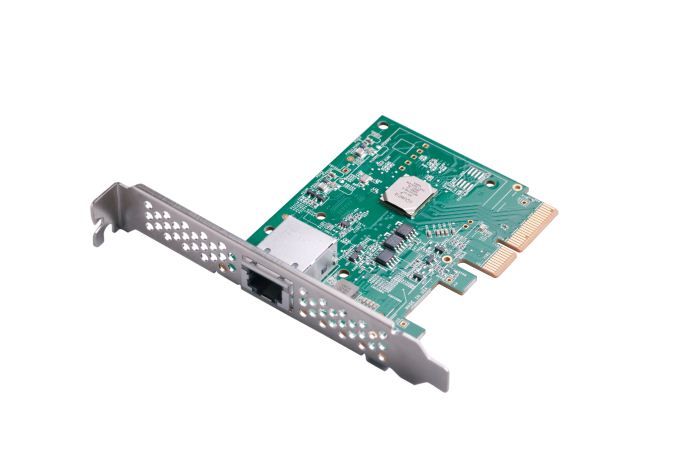
Late last year, Aquantia launched their range of multi-gigabit Ethernet controllers. These were controllers that could enable 1G, 2.5G and 5G connections over standard RJ45 connectors and Cat5e cabling. At the time, the two launched controllers were offered to OEMs to add into their custom motherboard builds, such as enterprise focused machines with a 5G office network in place. We have also seen motherboard manufacturers pick up the mantle, with consumer motherboards such as the ASRock Z270 SuperCarrier and the ASRock X370 Gaming, using the 5G Aquantia AQtion AQC108 chip.
Today's announcement cements Aquantia's lead in the multi-gigabit Ethernet space, despite already having an apparent 2 year lead over other rivals in this space (it helps that Aquantia helped define a major part of the 2.5G/5G specifications in the NBASE-T Alliance). Aquantia is launching two PCIe-based single-port network cards using their AQC108 and AQC107 controllers.
| Aquantia AQtion Multi-Gigabit NICs | ||
| Card | AQN-107 | AQN-108 |
| Controller | AQC-107 | AQC-108 |
| 100BASE-T | Yes | Yes |
| 1000BASE-T | Yes | Yes |
| 2.5GBASE-T | Yes | Yes |
| 5GBASE-T | Yes | Yes |
| 10GBASE-T | Yes | No |
| Ports | 1 | 1 |
| Price (from Aquantia) | $127 | $99 |
| Release Date | Soon | Soon |
| Potential Resellers | ASUS GIGABYTE |
? |
Both of these cards equip a system with a single port, with the AQC108 based card supporting BASE-T standards from 100M to 1G, 2.5G and 5G and uses a PCIe 3.0 x1 interface. The beefier AQC107 based card supports the same standards as well as 10G, and uses a PCIe 3.0 x4 interface (both cards will work down to PCIe 2.0 x1, with reduced data rates). Drivers for both cards will be available for the Windows 7/8/8.1/10 (also as part of the Windows Update solution) as well as varieties of Linux (3.10, 3.12, 3.2, 4.2 and 4.4).
The idea behind these cards is the same as other network cards - to be able to offer functionality without having to embed the controller on the motherboard or into a prebuilt/legacy system. In the consumer world, we have plenty of offerings of Intel and Realtek based gigabit Ethernet cards (even Killer NICs back in the day), and Intel commands the 10GBASE-T cards with its X540 and X550 series. Aquantia is hoping to shake up this market, particularly for businesses and end users willing to invest in 2.5G/5G infrastructure.
One of the big questions surrounding the transition to 2.5G/5G for home and SMB is infrastructure - making sure the network backbone, switches and access points are all capable. The major enterprise network players are already deploying multi-gigabit Ethernet networks to their customers, however it will be a bit longer before commercially available switches for consumers are available. One of the major drawbacks investing in 10GBASE-T in the home right now, aside from the $100-200 per port PCIe cards, is the cost of the switches. This is something Aquantia isn't doing directly, but we have been told that they are working with partners (the typical enterprise players at least) to solve. The depth of those solutions remain to be seen (we've been told similar by 10G switch vendors who had a different interpretation of 'mass market'), but ultimately for this technology to become ubiquitous, we need to see cheaper switches ($25/port), followed by cheap implementations, as we have seen in the last 15-20 years with gigabit Ethernet.
Final pricing is set at $99 and $127, with the 5G card being cheaper over the 10G card. Aquantia stated in the briefing that they are planning to sell the cards direct to consumers, or OEMs can brand the cards in their own style (eg imagine gaming based cards, as we've seen from Gigabyte already, or ASUS and their recently announced ROG Areion 10G card using the AQC107 chip) for their customers. It would be interesting to see if a manufacturer will offer a multi-port card by placing 2-4 chips on the same PCB, even if it requires a basic PLX switch. Four 1G/2.5G/5G/10G ports for $549, anyone?
Review samples are currently being circulated, and I'm discussing with Ganesh the best way to test them, especially as we don't have any 5G switch equipment. We're also looking at angles to test these ports as they appear on motherboards too. Aquantia expects the cards to be on shelves shortly, with branded cards to follow.


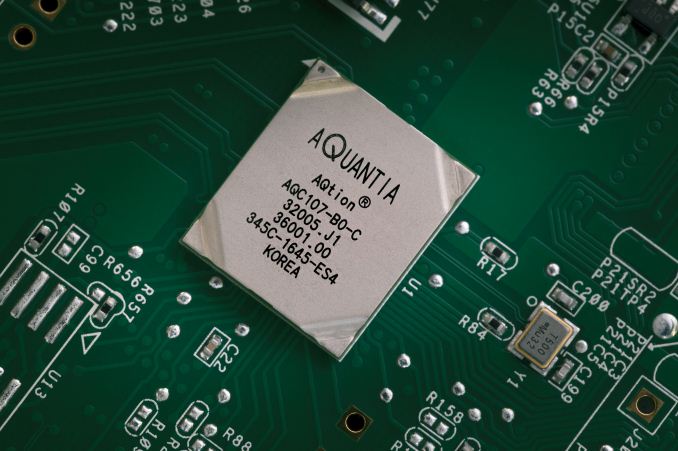
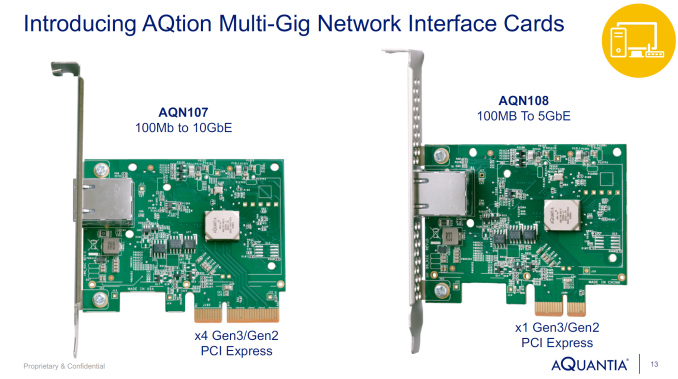
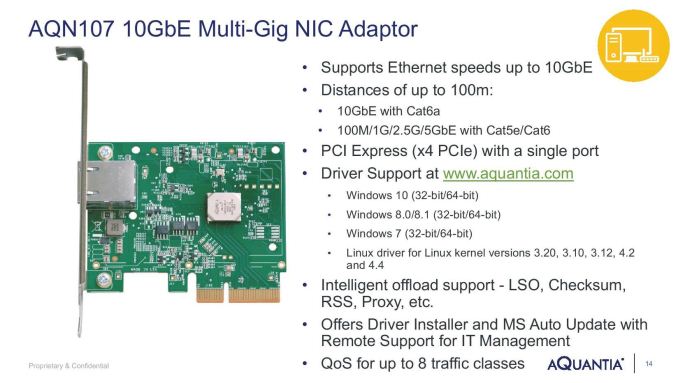
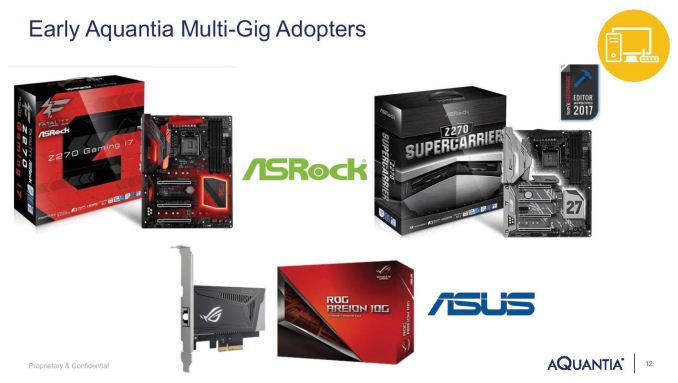
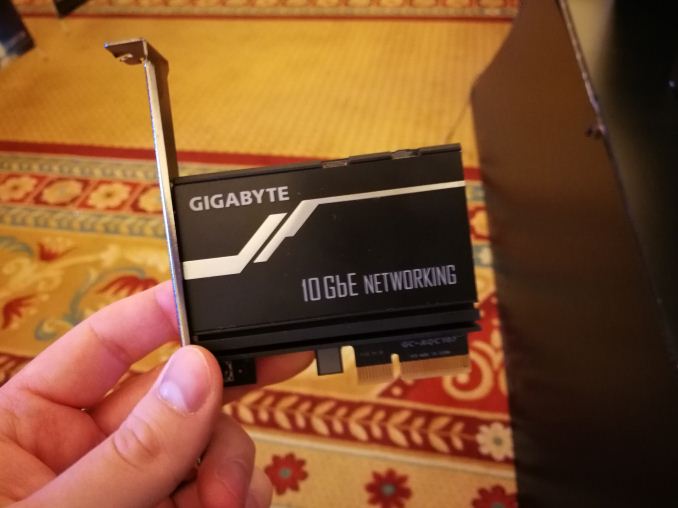




















33 Comments
View All Comments
Xajel - Monday, May 15, 2017 - link
Nice, while still expensive, I hope now to see more multi-gigabit Switches targeted towards consumer/prosumer.And please Ubiquiti, remake the 8/16 ports PoE switches with multi-gigabit support.. and not over priced like your current ones...
chechito - Monday, May 15, 2017 - link
i agree, vendors are trying to sell 5g ethernet at almost the cost of 10g ethernetBurntMyBacon - Monday, May 15, 2017 - link
In theory, 2.5G and 5G are good for the market as they provide a lower cost competitor to 10G that should drive down prices of 10G equipment. However, my fear and what seems to be playing out in practice is that 2.5G and 5G are being used to prop up the price of current 10G equipment. Vendors are justifying their 10G pricing by pricing their half and quarter speed alternatives such that it is extremely short sighted not to spend the small additional premium to get all the way to 10G.On the other hand, the AQN107 is selling for a reasonable price premium over the AQN108. The ability to support 2.5G, 5G, and 10G gives options for when the infrastructure is less than ideal. Switches with these extra modes will be desirable for the same reason. The AQN108 makes sense as an upgrade for systems that can't support an extra PCIe x4 card. However, while support for 2.5G and 5G at the switch is desirable, I see no reason to get a switch that doesn't also support 10G. It would be extremely short sighted. Likely, vendors will try to play with pricing, but we can already see that there isn't a large price difference. If a larger price gap develops, it will most likely be because vendors want to create the disparity and not due to a significantly greater cost of manufacturing 10G components.
dtremit - Monday, May 15, 2017 - link
The big advantage of 2.5G and 5G isn't port cost -- it's cable cost. 10Gbase-T won't run over the Cat5e/Cat6 cable that's installed pretty much everywhere -- it's even picky about Cat7. The cost of a $100 adapter is chump change relative to rewiring your building.chechito - Monday, May 15, 2017 - link
i think that is nic vendors charging you a plus for avoiding change your cable??? very sad!!!5g nic costs 10 times 1g nic thats 100% overprice vs performance
Kvaern1 - Monday, May 15, 2017 - link
Highend always comes at a premium. Always.Xajel - Monday, May 15, 2017 - link
I feel that from a consumer POV if they need 10G it will be for the backbone, like from the main switch to NAS to the main PC most these stuff in most homes are in the same room already. the rest can be wired using 5gbps with ease.For the way I see it, the 10G will be from NAS to main PC to main switch, all in same room.
and 5G to the home theatre switch which will connect to several 1G devices like TV, Media Player, Game Console, ChromeCast, etc..
2.5G/5G will also serve AP's either point to point or chained ( like Switch-5G>------>AP>---->AP ),
2.5G will enough for single AC AP, 5G will be good for chaining multiple AP's.
DanNeely - Monday, May 15, 2017 - link
For the shorter runs that are common at home lesser cabling than the officially rated sort is often still good enough. Cat6 (not 6A) is rated for 55m at 10G; runs that long in a residential network are rare. The bigger issue, especially with DIY cabling is that the quality of crimping at the cable ends needs to meet higher tolerances than with 1G.yuhong - Tuesday, May 16, 2017 - link
The fun thing is that the 802.3bz standard don't refer to Cat5e or Cat6 but describe the requirements in the standard itself. I wonder if this is due to marketing.voicequal - Thursday, May 18, 2017 - link
Interesting. Sometimes that means that the standards bodies aren't getting along. According to wikipedia there are conflicting specifications for Cat6A."Confusion therefore arises because of the different naming conventions and performance benchmarks laid down by the International ISO/IEC and American TIA/EIA standards, which in turn are different from the regional European standard, EN 50173-1." - Source Wikipedia